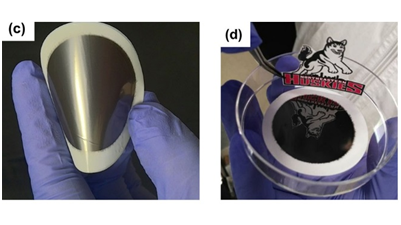 Metallic and highly conducting two-dimensional atomic arrays of sulfur enabled by molybdenum disulfide nanotemplate (通过二硫化钼纳米模板激活而具有金属性和高导电率的二维硫原子排布)
Metallic and highly conducting two-dimensional atomic arrays of sulfur enabled by molybdenum disulfide nanotemplate (通过二硫化钼纳米模板激活而具有金属性和高导电率的二维硫原子排布)
Shuze Zhu,Xiumei Geng,Yang Han,Mourad Benamara,Liao Chen,Jingxiao Li,Ismail Bilgin&Hongli Zhu
npj Computational Materials 3:41 (2017)
doi:10.1038/s41524-017-0041-z
Published online:05 October 2017
Abstract| Full Text | PDF OPEN
摘要:在自然界中,硫单质是一种绝缘体。研究发现,一维硫原子链呈现金属性和导电性,然而二维硫单质的电性能尚不清晰。本研究发现,二硫化钼层状结构可作为一类纳米模板来生长和形成二维硫单质。通过密度泛函理论的计算表明,处于二硫化钼层-层之间的硫原子由于受到空间的约束限制,可形成具有高度金属性的三角形平面结构。并且,这些平面结构激活了该杂合结构(由二硫化钼层和硫原子层构成)的高导电性和金属性。实验测得该杂合结构的电导率达到223 S / m。包括X射线光电子能谱(XPS)、透射电子显微镜(TEM)和选区电子衍射(SAED)等多项实验观测与计算结果一致。由于杂合结构的导电性能优异,在无导电添加剂的情况下,电流密度(小于30,000 mV/s)与扫描速率成线性相关。采用这种杂合结构作为电极,双电极超级电容器电池在离子液体电解质中的功率密度为106Wh/kg,能量密度达到47.5Wh/kg。本研究结果为采用二维材料及其范德华力异质结构作为纳米模板,来预测和设计外来原子的全新材料性质提供了新的方法。
Abstract:Element sulfur in nature is an insulating solid. While it has been tested that one-dimensional sulfur chain is metallic and conducting, the investigation on two-dimensional sulfur remains elusive. We report that molybdenum disulfide layers are able to serve as the nanotemplate to facilitate the formation of two-dimensional sulfur. Density functional theory calculations suggest that confined in-between layers of molybdenum disulfide, sulfur atoms are able to form two-dimensional triangular arrays that are highly metallic. As a result, these arrays contribute to the high conductivity and metallic phase of the hybrid structures of molybdenum disulfide layers and two-dimensional sulfur arrays. The experimentally measured conductivity of such hybrid structures reaches up to 223 S/m. Multiple experimental results, including X-ray photoelectron spectroscopy (XPS), transition electron microscope (TEM), selected area electron diffraction (SAED), agree with the computational insights. Due to the excellent conductivity, the current density is linearly proportional to the scan rate until 30,000 mV s−1without the attendance of conductive additives. Using such hybrid structures as electrode, the two-electrode supercapacitor cells yield a power density of 106 Wh kg−1and energy density ~47.5 Wh kg−1 in ionic liquid electrolytes. Our findings offer new insights into using two-dimensional materials and their Van der Waals heterostructures as nanotemplates to pattern foreign atoms for unprecedented material properties.
Editorial Summary
2D hybrids: alternating layers of MoS2and atomic sulfur(2D杂合:MoS2和硫单质的交替层状结构)
以二硫化钼(MoS2)层状结构作为纳米模板,可制备出二维元素硫。由美国东北大学朱红丽率领的团队采用密度泛函理论的计算发现,夹在MoS2层状结构之间的硫原子由于受到MoS2层与层之间的限制,可排列形成具有二维结构特征的三角形阵列。这些阵列具有金属性,因此有助于杂合结构(由MoS2层和二维硫层交替组成)出现金属相,表现出导电性。实验测得该杂合结构具有高达223 S/m的电导率。该方法可拓展到以纳米模板为依托,实现其它二维杂合材料的制备和设计。
Molybdenum disulfide (MoS2) layers can be used as templates for the formation of two-dimensional elemental sulfur. A team led by Hongli Zhu at Northeastern University used density functional theory calculations to show that the sulfur atoms sandwiched between MoS2 layers can arrange themselves into two-dimensional atomic layers, featuring a triangular array structure that results from the intrinsic triangular pattern of the parent sulfur atoms within MoS2. These arrays are metallic, and thus contribute to the metallic phase and associated conductivity of the resulting hybrid structure composed of alternating MoS2 layers and two-dimensional sulfur layers. The experimentally synthesized compounds show conductivity up to 223 S/m. This strategy may be used for engineering of two-dimensional material hybrids by means of nano-template patterns.


 沪公网安备 31010502006565号
沪公网安备 31010502006565号